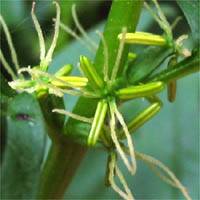
KalanchoeKAL-ən-KOH-ee, also written Kalanchöe or Kalanchoë, is a genus of about 125 species of tropical, succulent plants in the stonecrop family Crassulaceae, mainly native to Madagascar and tropical Africa. A Kalanchoe species was one of the first plants to be sent into space, sent on a resupply to the Soviet Salyut 1 space station in 1979. The majority of kalanchoes require around 6-8 hours of sunlight a day; a few cannot tolerate this, and survive with bright, indirect sunlight to bright shade.

Joseph Nelson Rose was an American botanist. He was born in Union County, Indiana. His father died serving during the Civil War when Joseph Rose was a young boy. He later graduated from high school in Liberty, Indiana.

Heliopsis is a genus of herbaceous flowering plants in the family Asteraceae, native to dry prairies in North and South America. The sunflower-like composite flowerheads are usually yellow, up to 8 cm (3 in) in diameter, and are borne in summer. Species are commonly called ox-eye or oxeye.

The Datiscaceae are a family of dicotyledonous plants, containing two species of the genus Datisca. Two other genera, Octomeles and Tetrameles, are now classified in the family Tetramelaceae.

Datisca glomerata is a species of plant native to California, Nevada, and Baja California known by the common name Durango root. It is one of only two to four species in the plant family Datiscaceae. It is an erect perennial herb with distinctive long, pointed, often sharply serrated leaves. It is said to superficially resemble Cannabis species. Its yellowish green flowers grow in clusters from the axilla of the leaf, where it joins the stem. A thick stand of the plant can form a medium-sized bush. All parts of this plant are toxic and in some areas it is considered a noxious weed. It is reported to be poisonous to cattle.

Guardiola is a genus of plants in the family Asteraceae, native to Mexico and the southwestern United States. Members of the genus are subshrubs with simple, opposite leaves and terminal inflorescences.

Carphochaete is a genus of North American flowering plants in the family Asteraceae. They are native to Mexico and the southwestern United States. They are known commonly as bristleheads.
Minuartia rosei is an uncommon species of flowering plant in the family Caryophyllaceae known by the common names peanut sandwort and peanut stitchwort.

Asarina is a flowering plant genus of only one species, Asarina procumbens Mill. the trailing snapdragon, which is native to France and Spain and introduced in Germany, Switzerland, Austria and Hungary. Originally placed in the Scrophulariaceae, the genus has more recently been moved to the Plantaginaceae. Species from North America formerly placed in the genus Asarina are now placed in Holmgrenanthe, Lophospermum, Mabrya and Maurandya, as well as Neogaerrhinum. Asarina is now regarded as exclusively an Old World genus.

Maurandya is a genus of flowering plants in the family Plantaginaceae, native to Mexico and the south west United States. They sprawl or climb by means of twining leaf stalks. One of the four species, Maurandya barclayana, is widely cultivated as an ornamental plant.

The Hylocereeae are a tribe of cacti. Most are found in the tropical forests of Central and northern South America, and are climbers or epiphytes, unlike most cacti. The tribe includes between six and eight genera in different circumscriptions. The plants known as "epiphyllum hybrids" or "epiphyllums", widely grown for their flowers, are hybrids of species within this tribe, particularly Disocactus, Pseudorhipsalis and Selenicereus, less often Epiphyllum, in spite of the common name.

Mabrya is a genus of flowering plants in the plantain family, Plantaginaceae. It consists of herbaceous perennials with brittle upright or drooping stems, found in dry areas of Mexico and the southern United States.
Mabrya rosei is a mat-forming herbaceous perennial native to the Mexican states of Jalisco and Zacatecas. It has tubular flowers, whitish at the base and red to red-violet at the apex. It was first described by Philip A. Munz in 1926 in the genus Maurandya and transferred to Mabrya by Wayne J. Elisens in 1985. Munz did not explain the origin of the epithet rosei but listed the collector of the type specimen as Joseph Nelson Rose.
Brickellia vernicosa is a Mexican species of flowering plants in the family Asteraceae. It is native to north-central Mexico, in the states of Durango, Zacatecas, and Chihuahua.
Grindelia oxylepis, the Mexican gumweed, is a North American species of flowering plants in the family Asteraceae. It is native to northern Mexico, in the States of Chihuahua, Coahuila, Durango, San Luis Potosí, and Zacatecas. The natural range barely crosses the Río Grande into the United States, with a few populations in western Texas and southern New Mexico
Guardiola platyphylla, the Apache plant, is a North American species of plants in the family Asteraceae, native to Mexico and the southwestern United States. It is found in northwestern Mexico and the southwestern United States.
Guardiola carinata is a rare North American species of plants in the family Asteraceae. It is found only in northern Mexico in the state of Nayarit.
Guardiola odontophylla is a rare North American species of plants in the family Asteraceae. It is found only in northern Mexico in the state of Durango.
Guardiola angustifolia is a rare North American species of plants in the family Asteraceae. It is found only in western Mexico in the state of Jalisco.
Asarum rosei is a species of flowering plant endemic to North Carolina in the southeastern United States. It was first formally described in 2017 by Brandon T. Sinn in Phytotaxa. The species is named for Mark Rose, "a respected plant collector, horticulturalist, orchid breeder, and naturalist who discovered and documented the species".









